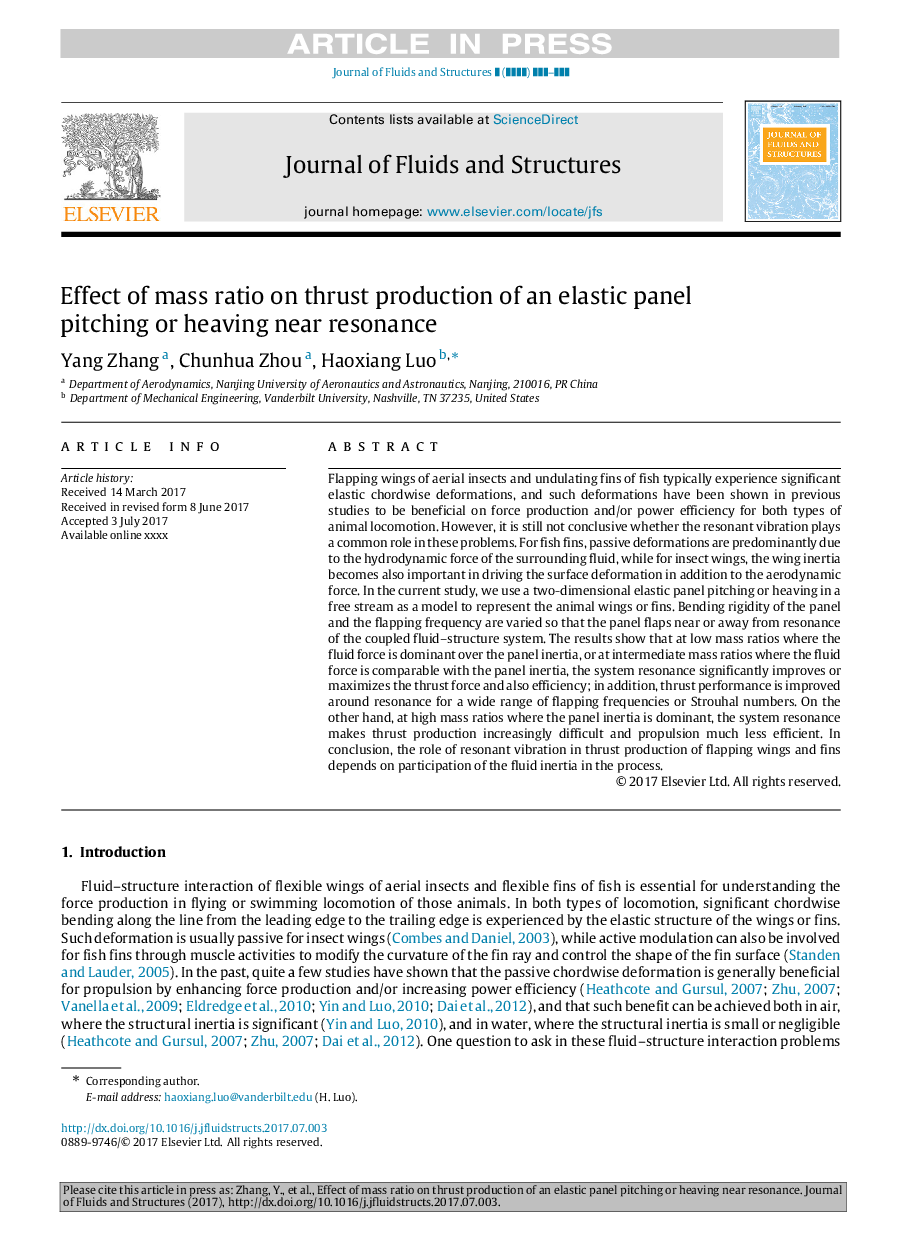| کد مقاله | کد نشریه | سال انتشار | مقاله انگلیسی | نسخه تمام متن |
|---|---|---|---|---|
| 5017404 | 1466573 | 2017 | 16 صفحه PDF | دانلود رایگان |
عنوان انگلیسی مقاله ISI
Effect of mass ratio on thrust production of an elastic panel pitching or heaving near resonance
ترجمه فارسی عنوان
اثر نسبت جرم به تولید محرک پانل کشویی الاستیک و یا افزایش در نزدیکی رزونانس
دانلود مقاله + سفارش ترجمه
دانلود مقاله ISI انگلیسی
رایگان برای ایرانیان
ترجمه چکیده
بال های مشتعل از حشرات هوایی و باله های رگ های ماهی به طور معمول تغییرات شیب الاستیک قابل توجهی را تجربه می کنند و چنین تغییرات در مطالعات قبلی نشان داده شده است که برای تولید نیرو و / یا بهره وری انرژی برای هر دو نوع حمل و نقل حیوانی سودمند است. با این وجود هنوز مشخص نیست که آیا ارتعاش رزونانس در این مشکلات نقش کلیدی دارد یا خیر. برای باله ماهی، تغییر شکل غیر فعال در بیشتر موارد به دلیل نیروی هیدرودینامیکی مایع اطراف است، در حالی که برای بال های حشرات، در جهت رانندگی تغییر شکل در سطح علاوه بر نیروی آیرودینامیکی، نیز مهم است. در مطالعه حاضر، ما از یک پانل الاستیک دو بعدی استفاده می کنیم که در یک جریان آزاد به عنوان یک مدل برای نشان دادن بال های حیوان یا باله ها استفاده می شود. خم شدن سفتی پانل و فرکانس چرخش به طوری که پانل فلپ نزدیک یا دور از رزونانس سیستم ساختار مایع همراه است. نتایج نشان می دهد که در مقادیر کم جرم که نیروی سیال بر روی درون پانلی غالب است یا در نسبت جرم متوسط که در آن نیروی مایع با پانل قابل مقایسه است، رزونانس سیستم به طور قابل توجهی نیروی محوری و همچنین بهره وری را بهبود می بخشد یا حداکثر می کند. علاوه بر این، عملکرد محوری در اطراف رزونانس برای طیف گسترده ای از فرکانس های فلپس یا تعداد استروهال بهبود می یابد. از سوی دیگر، در مقایسه با مقادیر جرمی که در آن نفوذ پانل غالب است، رزونانس سیستم باعث می شود که تولید محرک به طور فزاینده ای دشوار شود و نیروی محرکه بسیار کارآمد باشد. در نتیجه، نقش ارتعاش رزونانس در تولید رانش بال ها و باله های فلپس بستگی به مشارکت اینرسی مایع در فرآیند دارد.
موضوعات مرتبط
مهندسی و علوم پایه
سایر رشته های مهندسی
مهندسی مکانیک
چکیده انگلیسی
Flapping wings of aerial insects and undulating fins of fish typically experience significant elastic chordwise deformations, and such deformations have been shown in previous studies to be beneficial on force production and/or power efficiency for both types of animal locomotion. However, it is still not conclusive whether the resonant vibration plays a common role in these problems. For fish fins, passive deformations are predominantly due to the hydrodynamic force of the surrounding fluid, while for insect wings, the wing inertia becomes also important in driving the surface deformation in addition to the aerodynamic force. In the current study, we use a two-dimensional elastic panel pitching or heaving in a free stream as a model to represent the animal wings or fins. Bending rigidity of the panel and the flapping frequency are varied so that the panel flaps near or away from resonance of the coupled fluid-structure system. The results show that at low mass ratios where the fluid force is dominant over the panel inertia, or at intermediate mass ratios where the fluid force is comparable with the panel inertia, the system resonance significantly improves or maximizes the thrust force and also efficiency; in addition, thrust performance is improved around resonance for a wide range of flapping frequencies or Strouhal numbers. On the other hand, at high mass ratios where the panel inertia is dominant, the system resonance makes thrust production increasingly difficult and propulsion much less efficient. In conclusion, the role of resonant vibration in thrust production of flapping wings and fins depends on participation of the fluid inertia in the process.
ناشر
Database: Elsevier - ScienceDirect (ساینس دایرکت)
Journal: Journal of Fluids and Structures - Volume 74, October 2017, Pages 385-400
Journal: Journal of Fluids and Structures - Volume 74, October 2017, Pages 385-400
نویسندگان
Yang Zhang, Chunhua Zhou, Haoxiang Luo,
